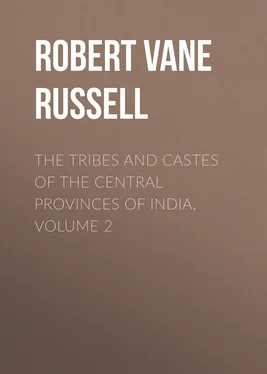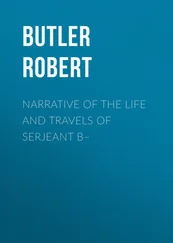Robert Vane Russell - The Tribes and Castes of the Central Provinces of India, Volume 2
Здесь есть возможность читать онлайн «Robert Vane Russell - The Tribes and Castes of the Central Provinces of India, Volume 2» — ознакомительный отрывок электронной книги совершенно бесплатно, а после прочтения отрывка купить полную версию. В некоторых случаях можно слушать аудио, скачать через торрент в формате fb2 и присутствует краткое содержание. Жанр: foreign_prose, История, foreign_edu, foreign_antique, на английском языке. Описание произведения, (предисловие) а так же отзывы посетителей доступны на портале библиотеки ЛибКат.
- Название:The Tribes and Castes of the Central Provinces of India, Volume 2
- Автор:
- Жанр:
- Год:неизвестен
- ISBN:нет данных
- Рейтинг книги:4 / 5. Голосов: 1
-
Избранное:Добавить в избранное
- Отзывы:
-
Ваша оценка:
- 80
- 1
- 2
- 3
- 4
- 5
The Tribes and Castes of the Central Provinces of India, Volume 2: краткое содержание, описание и аннотация
Предлагаем к чтению аннотацию, описание, краткое содержание или предисловие (зависит от того, что написал сам автор книги «The Tribes and Castes of the Central Provinces of India, Volume 2»). Если вы не нашли необходимую информацию о книге — напишите в комментариях, мы постараемся отыскать её.
The Tribes and Castes of the Central Provinces of India, Volume 2 — читать онлайн ознакомительный отрывок
Ниже представлен текст книги, разбитый по страницам. Система сохранения места последней прочитанной страницы, позволяет с удобством читать онлайн бесплатно книгу «The Tribes and Castes of the Central Provinces of India, Volume 2», без необходимости каждый раз заново искать на чём Вы остановились. Поставьте закладку, и сможете в любой момент перейти на страницу, на которой закончили чтение.
Интервал:
Закладка:
After marriage a girl goes to her husband’s house for a few days and returns. The first Diwāli or Akha-tīj festival after the wedding must also be passed at the husband’s house, but consummation is not effected until the aina or gauna ceremony is performed on the attainment of puberty. The cost of a wedding is about Rs. 80 to the bridegroom’s family and Rs. 20 to the bride’s family. A widow is forbidden to marry her late husband’s brother or other relatives. At the wedding she is dressed in new clothes, and the foreheads of the couple are marked with cowdung as a sign of purification. They then proceed by night to the husband’s village, and the woman waits till morning in some empty building, when she enters her husband’s house carrying two water-pots on her head in token of the fertility which she is to bring to it.
3. Other customs.
Like the Mahārs, the Balāhis must not kill a dog or a cat under pain of expulsion; but it is peculiar that in their case the bear is held equally sacred, this being probably a residue of some totemistic observance. The most binding form of oath which they can use is by any one of these animals. The Balāhis will admit any Hindu into the community except a man of the very lowest castes, and also Gonds and Korkus. The head and face of the neophyte are shaved clean, and he is made to lie on the ground under a string-cot; a number of the Balāhis sit on this and wash themselves, letting the water drip from their bodies on to the man below until he is well drenched; he then gives a feast to the caste-fellows, and is considered to have become a Balāhi. It is reported also that they will receive back into the community Balāhi women who have lived with men of other castes and even with Jains and Muhammadans. They will take food from members of these religions and of any Hindu caste, except the most impure.
Balija
1. Origin and traditions.
Balija, Balji, Gurusthulu, Naidu.—A large trading caste of the Madras Presidency, where they number a million persons. In the Central Provinces 1200 were enumerated in 1911, excluding 1500 Perikis, who though really a subcaste and not a very exalted one of Balijas, 111 111 Madras Census Report (1891), p. 277.
claim to be a separate caste. They are mainly returned from places where Madras troops have been stationed, as Nāgpur, Jubbulpore and Raipur. The caste are frequently known as Naidu, a corruption of the Telugu word Nāyakdu, a prince or leader. Their ancestors are supposed to have been Nāyaks or kings of Madura, Tanjore and Vijayanagar. The traditional occupation of the caste appears to have been to make bangles and pearl and coral ornaments, and they have still a subcaste called Gāzulu, or a bangle-seller. In Madras they are said to be an offshoot of the great cultivating castes of Kamma and Kāpu and to be a mixed community recruited from these and other Telugu castes. Another proof of their mixed descent may be inferred from the fact that they will admit persons of other castes or the descendants of mixed marriages into the community without much scruple in Madras. 112 112 Ibidem (1891), p. 226.
The name of Balija seems also to have been applied to a mixed caste started by Bāsava, the founder of the Lingāyat sect of Sivites, these persons being known in Madras as Linga Balijas.
2. Marriage.
The Balijas have two main divisions, Desa or Kota, and Peta, the Desas or Kotas being those who claim descent from the old Balija kings, while the Petas are the trading Balijas, and are further subdivided into groups like the Gāzulu or bangle-sellers and the Periki or salt-sellers. The subdivisions are not strictly endogamous. Every family has a surname, and exogamous groups or gotras also exist, but these have generally been forgotten, and marriages are regulated by the surnames, the only prohibition being that persons of the same surname may not intermarry. Instances of such names are: Singiri, Gūdāri, Jadal, Sangnād and Dāsiri. In fact the rules of exogamy are so loose that an instance is known of an uncle having married his niece. Marriage is usually infant, and the ceremony lasts for five days. On the first day the bride and bridegroom are seated on a yoke in the pandal or marriage pavilion, where the relatives and guests assemble. The bridegroom puts a pair of silver rings on the bride’s toes and ties the mangal-sūtram or flat circular piece of gold round her neck. On the next three days the bridegroom and bride are made to sit on a plank or cot face to face with each other and to throw flowers and play together for two hours in the mornings and evenings. On the fourth day, at dead of night, they are seated on a cot and the jewels and gifts for the bride are presented, and she is then formally handed over to the bridegroom’s family. In Madras Mr. Thurston 113 113 Ethnographic Notes in Southern India , p. 16.
states that on the last day of the marriage ceremony a mock ploughing and sowing rite is held, and during this, the sister of the bridegroom puts a cloth over the basket containing earth, wherein seeds are to be sown by the bridegroom, and will not allow him to go on with the ceremony till she has extracted a promise that his first-born daughter shall marry her son. No bride-price is paid, and the remarriage of widows is forbidden.
3. Occupation and social status.
The Balijas bury their dead in a sitting posture. In the Central Provinces they are usually Lingāyats and especially worship Gauri, Siva’s wife. Jangams serve them as priests. They usually eat flesh and drink liquor, but in Chānda it is stated that both these practices are forbidden. In the Central Provinces they are mainly cultivators, but some of them still sell bangles and salt. Several of them are in Government service and occupy a fairly high social position.
In Madras a curious connection exists between the Kāpus and Balijas and the impure Māla caste. It is said that once upon a time the Kāpus and Balijas were flying from the Muhammadans and came to the northern Pallār river in high flood. They besought the river to go down and let them across, but it demanded the sacrifice of a first-born child. While the Kāpus and Balijas were hesitating, the Mālas who had followed them boldly sacrificed one of their children. Immediately the river divided before them and they all crossed in safety. Ever since then the Kāpus and Balijas have respected the Mālas, and the Balijas formerly even deposited the images of the goddess Gauri, of Ganesha, and of Siva’s bull with the Mālas, as the hereditary custodians of their gods. 114 114 Madras Census Report (1891), p. 277.
Bania
1. General notice.
Bania, Bāni, Vāni, Mahājan, Seth, Sāhukār.—The occupational caste of bankers, moneylenders and dealers in grain, ghī (butter), groceries and spices. The name Bania is derived from the Sanskrit vanij , a merchant. In western India the Banias are always called Vānia or Vāni. Mahājan literally means a great man, and being applied to successful Banias as an honorific title has now come to signify a banker or moneylender; Seth signifies a great merchant or capitalist, and is applied to Banias as an honorific prefix. The words Sāhu , Sao and Sāhukār mean upright or honest, and have also, curiously enough, come to signify a moneylender. The total number of Banias in the Central Provinces in 1911 was about 200,000, or rather over one per cent of the population. Of the above total two-thirds were Hindus and one-third Jains. The caste is fairly distributed over the whole Province, being most numerous in Districts with large towns and a considerable volume of trade.
Читать дальшеИнтервал:
Закладка:
Похожие книги на «The Tribes and Castes of the Central Provinces of India, Volume 2»
Представляем Вашему вниманию похожие книги на «The Tribes and Castes of the Central Provinces of India, Volume 2» списком для выбора. Мы отобрали схожую по названию и смыслу литературу в надежде предоставить читателям больше вариантов отыскать новые, интересные, ещё непрочитанные произведения.
Обсуждение, отзывы о книге «The Tribes and Castes of the Central Provinces of India, Volume 2» и просто собственные мнения читателей. Оставьте ваши комментарии, напишите, что Вы думаете о произведении, его смысле или главных героях. Укажите что конкретно понравилось, а что нет, и почему Вы так считаете.












